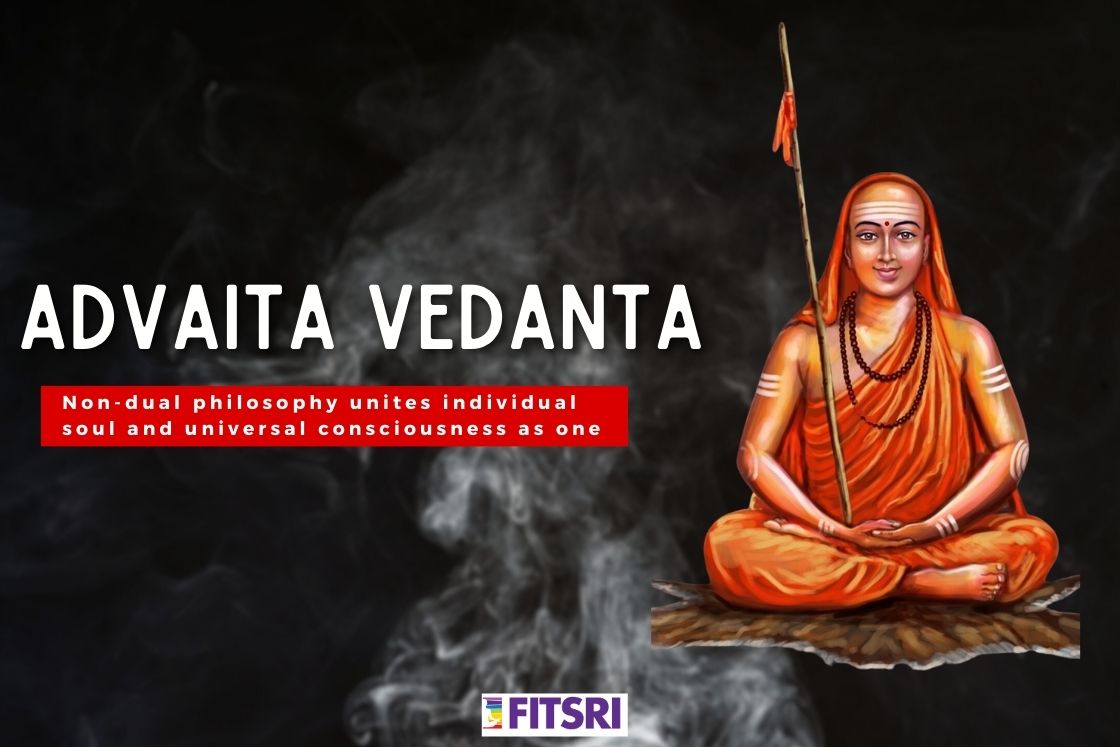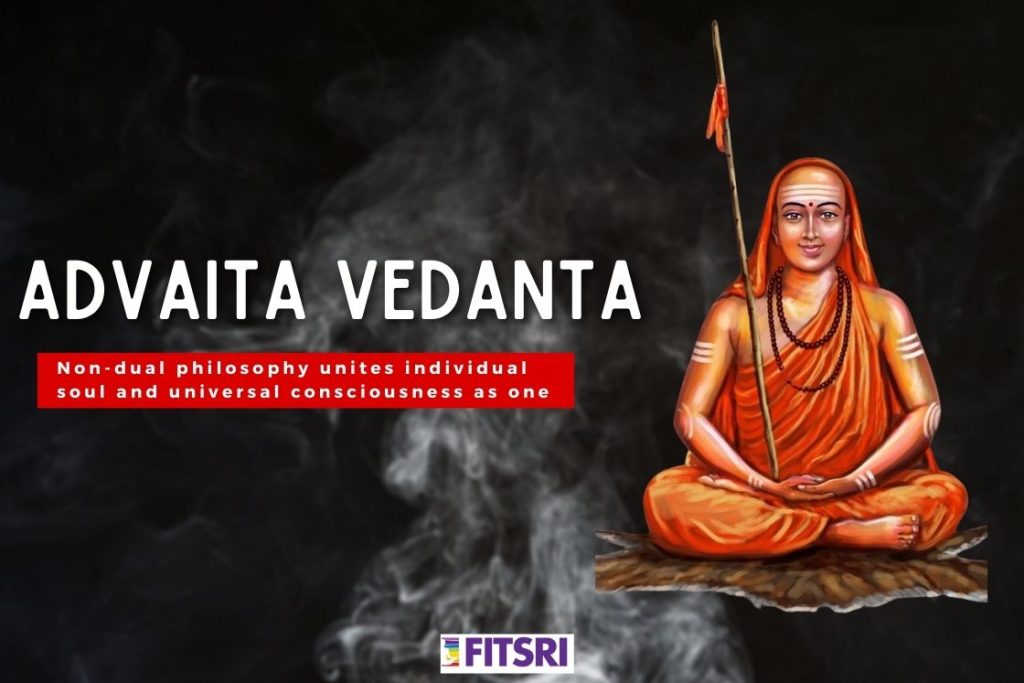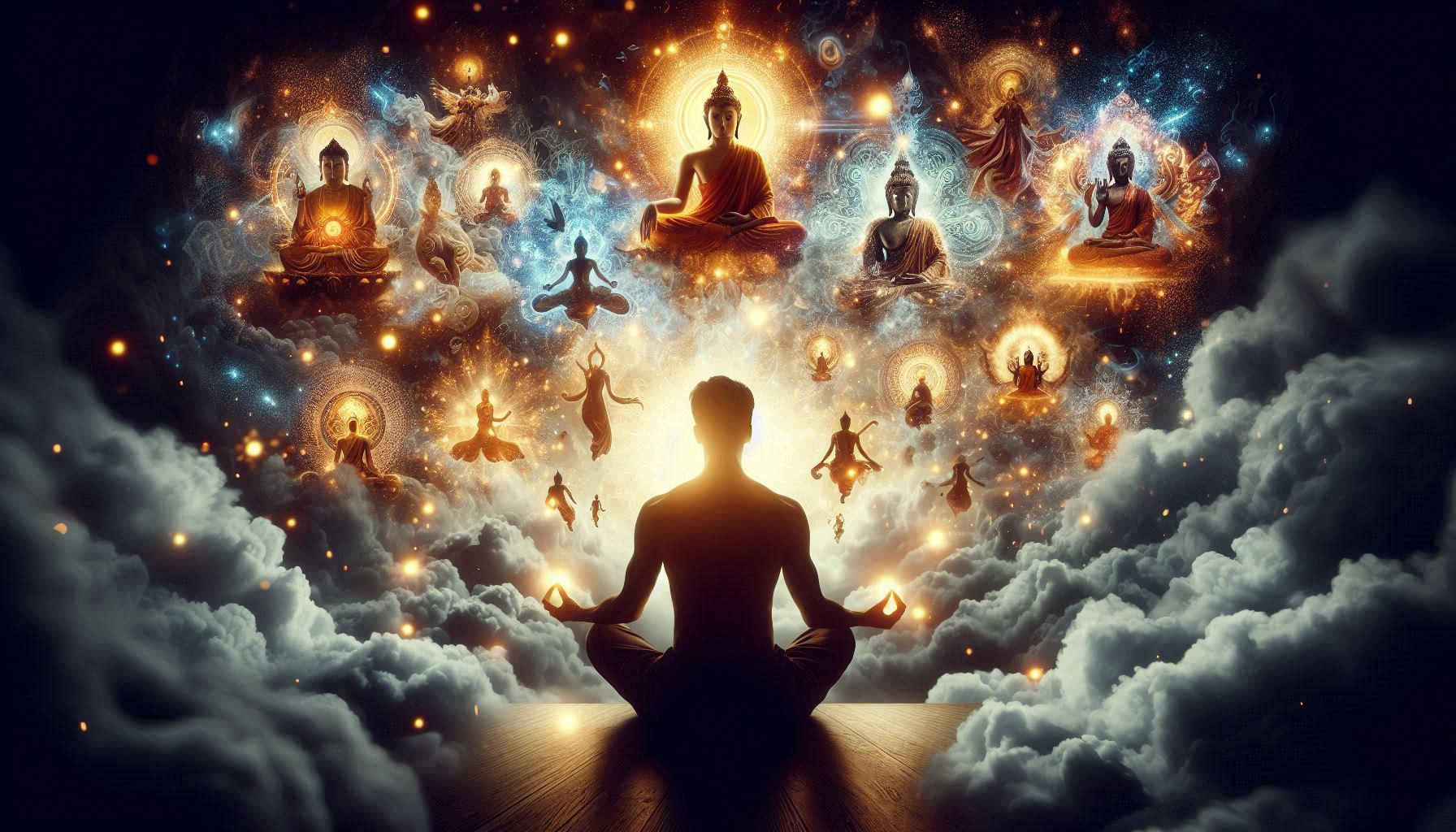Advaita Vedanta: The Philosophy of Non-Duality
Advaita Vedanta, a phrase that may seem complicated, has its roots deep embedded in the spiritual traditions of India. Going back thousands of years, this philosophy comes from the ancient Vedic scriptures, offer deep insights into the nature of...


Advaita Vedanta, a phrase that may seem complicated, has its roots deep embedded in the spiritual traditions of India. Going back thousands of years, this philosophy comes from the ancient Vedic scriptures, offer deep insights into the nature of existence. It did not arise suddenly, but developed gradually, drawing on various spiritual and philosophical texts..
Basic Tenets of Advaita Vedanta
Understanding Advaita Vedanta becomes simpler if we break it down:
Advaita: Derived from Sanskrit, “Advaita” means “not-two” or “non-dual.” At its heart, this concept posits that there’s no difference between the individual soul and the universal consciousness. Vedanta: This translates to “the end of knowledge.” It signifies the ultimate knowledge and understanding that one can attain, particularly relating to the nature of self and the universe.Together, the core principle of Advaita Vedanta states that there’s only one ultimate reality, and it’s the same within each one of us. The sense of individuality or separation we feel is due to our limited perceptions.
Adi Shankaracharya is a Key Figure in Advaita Vedanta
When talking about Advaita Vedanta, it’s impossible to overlook Adi Shankaracharya. Born in the early 8th century, he was more than a philosopher; he was a spiritual dynamo who revitalized and redefined Advaita Vedanta. His teachings emphasized that the ultimate reality or consciousness (often referred to as Brahman in Indian philosophy) is singular, and the soul (or Atman) is not different from it. Adi Shankaracharya’s interpretations, commentaries, and writings are still studied widely, and his impact is felt not just in India, but across the globe.
With this brief introduction, we’ve scratched the surface of the deep well of wisdom that is Advaita Vedanta. Whether you’re on a spiritual journey or just intrigued by philosophy, understanding this school of thought can offer profound insights into life and existence.
The Core Principles of Advaita Vedanta
The core principles, though profound, offer a roadmap to understanding ourselves and the universe from the perspective of Advaita Vedanta. Each principle nudges us closer to recognizing the simplicity and unity in the complex world around us.
Non-dualism (Advaita)
At the very heart of Advaita Vedanta lies the principle of non-dualism, which is essentially what the term “Advaita” stands for. It’s the idea that there’s no division or duality in the fundamental nature of the universe. In simpler terms, everything and everyone shares the same essence, a unified, singular reality. We might see different forms, beings, and objects, but beneath the surface, it’s all one interconnected reality.
Brahman (The Universal Soul)
Brahman is a core concept in Advaita Vedanta. Think of it as the ultimate force or energy in the universe. It’s formless, boundless, and eternal. But don’t mistake it for a deity or a god in the traditional sense. Brahman is beyond names, forms, and descriptions. It’s the underlying essence or foundation of everything. When we talk about the universe’s grand design or the source of all existence, we’re essentially talking about Brahman.
Atman (The Individual Soul)
Each one of us has a core, an inner self, often referred to as the soul or Atman in Advaita Vedanta. Here’s the fascinating part: this Atman is not different from Brahman. Our individual essence or soul is a direct reflection of that universal energy. The feelings of separateness or individuality are due to limited perceptions. When we truly recognize our inner self, we realize we’re part of the grand, unified reality.
Maya (Illusion)
Why do we feel separated or distinct from the rest of the universe if, at the core, it’s all one? The answer in Advaita Vedanta is Maya. Maya is the veil of illusion that makes us perceive diversity and differentiation. It’s like a filter that colors our perception of the world, leading us to misunderstand the true non-dual nature of existence. Overcoming this illusion is a central theme in Advaita Vedanta.
Moksha (Liberation)
Moksha can be viewed as the ultimate goal in Advaita Vedanta. It’s the state of liberation or freedom from the cycle of birth and death, and more importantly, from the grasp of Maya. Achieving Moksha means recognizing the oneness of Atman and Brahman, breaking free from all illusions, and experiencing the profound interconnectedness of all existence. It’s a realization of one’s true nature and the culmination of the Advaitic journey.
Scriptures and Texts of Advaita Vedanta
The theories and philosophies of Vedantic philosophy may seem overwhelming at first, but the scriptures and texts offer structured paths. Whether you’re searching for deep wisdom or simply want to understand the basics of Indian spiritual thought, these writings are the key to a treasure chest of knowledge.
Upanishads
The Upanishads, often referred to as the spiritual heart of the Vedas, are ancient texts that delve deeply into the nature of reality and the self. They form the basis for much of India’s spiritual philosophy. These texts are a compilation of dialogues, discussions and insights that explore the great questions of life. If you want to grasp the essence of Indian thought on topics such as existence, purpose, and the universe, the Upanishads are your starting point.
Brahma Sutras
The Brahma Sutras, also known as the Vedanta Sutras, serve as a systematic representation of the teachings found in the Upanishads. Authored by the sage Badarayana, these sutras are concise aphorisms that delve into the nature of Brahman, the ultimate reality. They are essentially a road map to guide the seeker through the vast landscape of Vedantic thought and help him navigate its intricacies.
Bhagavad Gita
The Bhagavad Gita, arguably one of the most famous Indian scriptures, is a 700 verse dialogue between Prince Arjuna and the god Krishna, who serves as his charioteer. The Gita is more than just a religious book, for it deals with duty, righteousness, and the paths to spiritual realisation. It beautifully combines philosophy, theology, and guidance for personal growth, making it a text of immeasurable value to everyone, regardless of their background.
Prakarana Granthas (introductory texts)
For those taking their first steps into Vedantic philosophy, the Prakarana Granthas are a boon. These are introductory texts, simplifying complex concepts and serving as a primer for the uninitiated. Authored by various sages and scholars, including the renowned Adi Shankaracharya, these texts break down Vedantic teachings into digestible bits, making the profound wisdom accessible to all.
Advaita Vedanta’s Relation to Yoga
The intertwining of Advaita Vedanta and yoga offers a holistic approach to self-discovery. While Advaita Vedanta provides the roadmap, yoga equips us with the tools to journey through it. Together, they pave the way for a deeper understanding of existence and our place within it.
How it complements yoga philosophies
Advaita Vedanta and yoga might seem like separate streams of thought, but they beautifully dovetail into each other. At the core, both focus on the understanding and realization of the true nature of the self. While yoga is often associated with physical postures, its true essence lies in spiritual development, aligning seamlessly with the principles of Advaita Vedanta. Yoga offers practical tools for personal growth, and Advaita Vedanta provides the philosophical backbone. Together, they guide seekers towards a unified understanding of self and the universe.
Practices aligned with Advaita principles
In yoga, certain practices resonate deeply with the teachings of Advaita Vedanta. The most notable among these is meditation focused on self-realization. Rather than merely being a relaxation tool, this form of meditation pushes one to peel back layers of perception, reaching the core essence of the self. The practice aids in dissolving the illusion of separateness (Maya), leading to the realization that the individual soul (Atman) and the universal consciousness (Brahman) are one. Breath control (pranayama) and ethical living (yama and niyama) are other yoga practices that bolster the journey of understanding and embodying Advaita Vedanta’s principles.
Advaita Vedanta in Modern Times
The ancient philosophy of Advaita Vedanta remains as relevant and vital today as it was millennia ago. Its contemporary torchbearers, coupled with a universal message, ensure that its light continues to guide, inspire, and uplift souls in our modern world.
Contemporary Teachers and Teachings
The timeless wisdom of Advaita Vedanta continues to inspire and guide, with contemporary teachers breathing new life into the ancient teachings. Personalities like Ramana Maharshi and Swami Vivekananda, while not exactly modern, paved the way for today and made Advaita Vedanta accessible beyond India’s borders. Today, teachers like Mooji, Rupert Spira, and Adyashanti bring fresh perspectives to these teachings and ensure that they resonate with the modern mind. These luminaries offer retreats, write books, and hold sessions around the world, ensuring that the spirit of Advaita Vedanta remains alive.
The Relevance of Advaita Vedanta in the Modern World
In a world of distractions and complexity, the simplicity and directness of Advaita Vedanta offer a refuge. Its core message – the interconnectedness of everything and the innate divinity within each of us – offers comfort and clarity. In an age grappling with individualism, materialism, and disconnectedness, Advaita Vedanta encourages introspection, unity, and true self-understanding. Its emphasis on self-realisation as the path to contentment contrasts with modern notions that external achievements are the primary sources of happiness.
The Global Appeal and Spread of its Teachings
Advaita Vedanta’s universal message of non-duality and inner peace transcends cultural and geographical boundaries. The teachings of Advaita Vedanta have found worldwide appeal, and study groups, retreats, and institutions dedicated to Advaita Vedanta are flourishing in various corners of the world. The universality of its principles–the pursuit of true self-knowledge and the realization of Oneness–appeals to the heart and makes it attractive to diverse populations. Whether in bustling metropolises or quiet rural areas, the voice of Advaita Vedanta finds eager listeners.
Practical Applications of Advaita Vedanta
Embracing the principles of Advaita Vedanta doesn’t require a complete overhaul of your life. With gradual steps, consistent practice, and genuine intent, the profound wisdom of non-duality can illuminate every corner of your daily existence.
How to Apply Advaita Vedanta Principles in Daily Life:
The teachings of Advaita Vedanta, while profound, are not just theoretical musings but are rooted in the practicalities of living a fulfilling life. Here’s how you can incorporate its principles daily:
Awareness: Regularly pause and be present. In the midst of a busy day, taking a moment to simply be aware of your surroundings and internal state can be a step towards recognizing the interconnectedness of all things. Non-Judgment: Approach situations and people without preconceived notions. This aligns with the idea of seeing the universal essence (Brahman) in everyone and everything. Simplicity: Minimize unnecessary clutter, both materially and mentally. This can help in perceiving reality without the distortions of Maya (illusion). Inner Reflection: Dedicate time daily for self-reflection, questioning the nature of your true self, and distinguishing between the ego and the Atman.Techniques and Practices for Self-Realization
To truly understand and embody the teachings of Advaita Vedanta, certain practices can serve as guiding lights:
Meditation: Start with a simple mindfulness meditation, focusing on your breath. Gradually, transition to self-inquiry meditation, where you contemplate questions like “Who am I?” to delve into the nature of your true self. Reading & Contemplation: Dive into core texts like the Upanishads or works by modern Advaita teachers. But don’t just read—reflect deeply on their teachings. Satsang: Attend gatherings or sessions with knowledgeable teachers or like-minded seekers. This shared pursuit can offer clarity and reinforce your understanding. Ethical Living: Align your actions with the principle of seeing the divine in all. This can mean practicing kindness, honesty, and non-violence in thoughts, words, and deeds.Conclusion
Advaita Vedanta, at its core, delves into the profound truth of non-duality, asserting that all of existence is interconnected. This age-old philosophy, originating from India’s sacred texts, resonates deeply even today. It offers clarity amidst the chaos of modern living, emphasizing the innate divinity within each of us and the interconnectedness of all things.
In a world often marked by divisions and distractions, Advaita Vedanta stands as a beacon, guiding seekers towards unity, understanding, and inner peace. Its teachings are not confined to scriptures but are immensely practical, providing tools for self-reflection, self-realization, and genuine contentment.
In sum, Advaita Vedanta’s importance cannot be overstated. It bridges ancient wisdom and contemporary challenges, providing a timeless roadmap for anyone seeking deeper meaning, purpose, and connection in their lives. Whether you’re a spiritual seeker or simply someone looking for grounding in today’s world, the principles of Advaita Vedanta offer a foundation of enduring value.
Frequently Asked Questions related to Advaita Vedanta
1. Who is God in Advaita Vedanta?
In Advaita Vedanta, God is referred to as “Brahman.” Brahman is the ultimate, unchanging reality, amidst and beyond the world. It’s not a deity in the conventional sense but rather the supreme consciousness or universal principle that underlies everything.
2. What is the difference between Vedanta and Advaita Vedanta?
“Vedanta” is a term derived from “Veda-anta” (the end of the Vedas) and refers to the Upanishads, which expound on the philosophical teachings of the Vedas. Vedanta has several sub-schools, each interpreting these teachings differently. “Advaita” Vedanta, with “Advaita” meaning non-dual, is one of these sub-schools. It emphasizes non-duality, suggesting that the individual soul and the universal soul are one.
3. Who founded Advaita Vedanta?
While the roots of Advaita Vedanta can be traced back to the Upanishads, Adi Shankaracharya (often simply referred to as Shankara) in the early 8th century CE is credited with consolidating and systematizing its teachings. He is often regarded as the founder or key propagator of Advaita Vedanta.
4. Who is Shiva according to Advaita?
In Advaita Vedanta, Shiva is considered a representation of the Supreme Brahman. He symbolizes the consciousness that pervades everything. While traditional religious practices may worship Shiva as a deity, in Advaita philosophy, Shiva is a manifestation of the ultimate reality or consciousness.
5. Is Bhagavad Gita based on Advaita Vedanta?
The Bhagavad Gita encompasses various philosophical teachings, and different sections can be interpreted in line with different Vedantic sub-schools. Advaita Vedantins see the Bhagavad Gita as supporting their view, especially in chapters where the oneness of the self with the ultimate reality is emphasized. However, the Gita is not exclusively an Advaita text, as it also incorporates elements that resonate with other Vedantic schools.
6. Who are the 5 teachers of Advaita Vedanta?
While there have been numerous teachers and proponents of Advaita Vedanta, the tradition often speaks of a lineage of principal teachers, known as the Dashanami Sampradaya. Among them, five are particularly revered:
Adi Shankaracharya: The primary consolidator of Advaita Vedanta. Padmapadacharya: A direct disciple of Shankara and author of several significant texts. Sureśvarāchārya: Another pivotal disciple of Shankara known for his works defending Advaita. Hastamalakacharya: Also a disciple of Shankara, known for his clarity on the teachings. Totakacharya: A renowned disciple of Shankara who composed influential verses on Advaita.7. What are the three levels of reality in Advaita Vedanta?
Advaita Vedanta describes three levels of reality:
Paramārthika Satyam (Absolute Reality): This is the highest level of reality, representing Brahman or the ultimate truth that is unchanging and eternal. Vyāvahārika Satyam (Empirical Reality): This is the level of reality we perceive in our daily lives – the world, people, objects. It’s considered real but is subject to change and thus is not the absolute reality. Prātibhāsika Satyam (Apparent Reality): This represents illusory or subjective reality, like dreams or hallucinations.
 KickT
KickT 

































